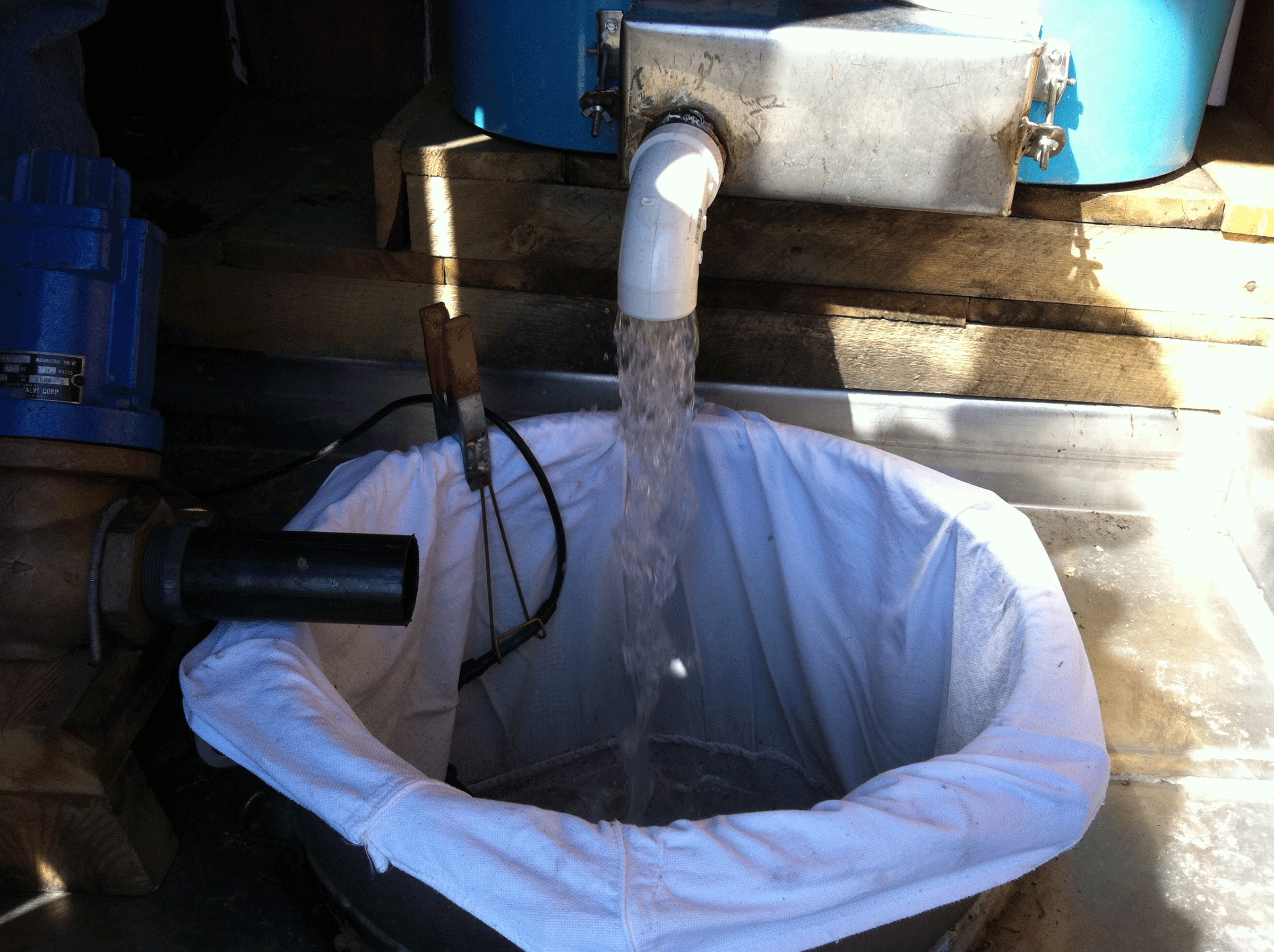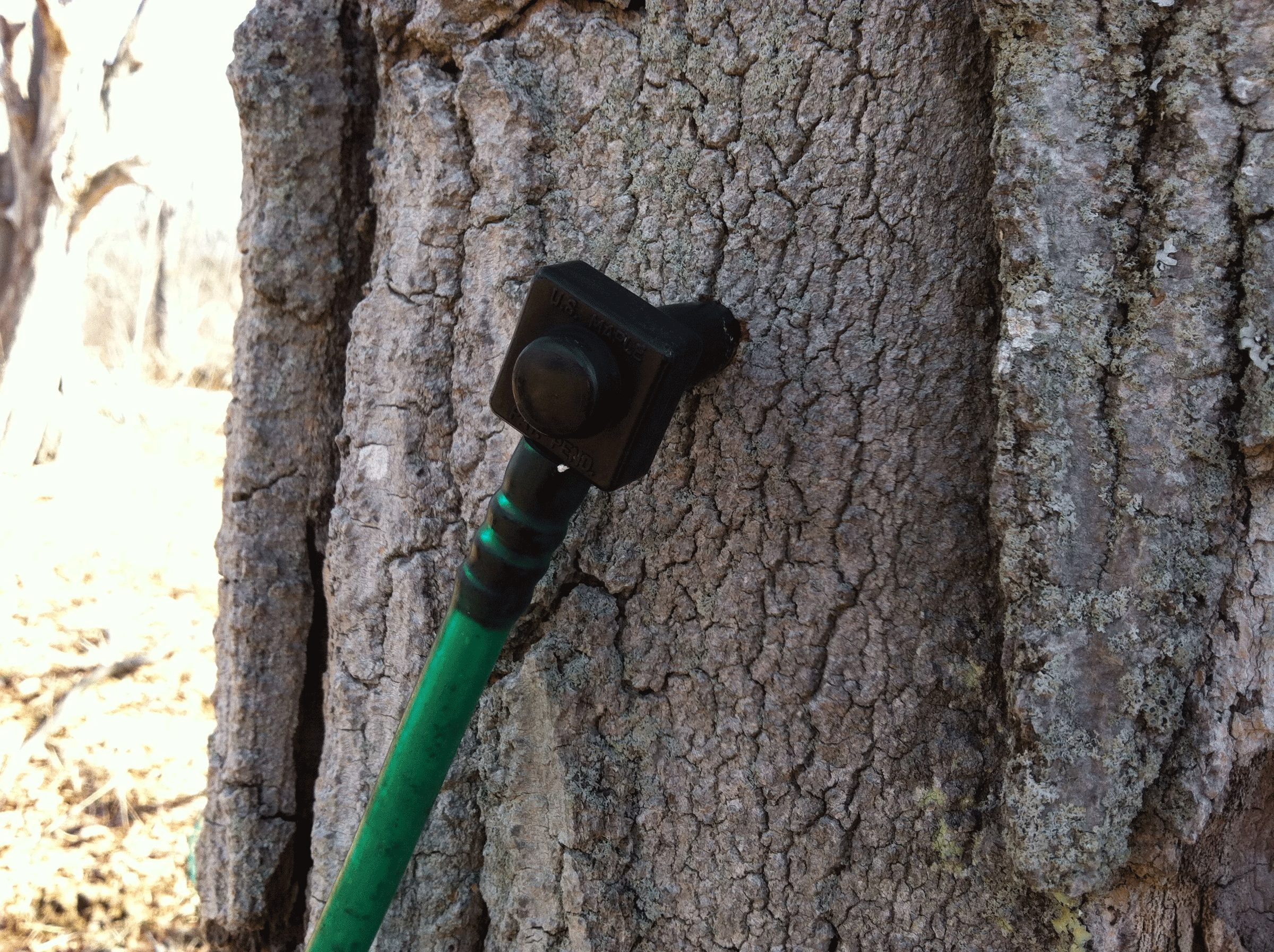Maple Syrup and Climate Change
Air Date: Week of April 4, 2014

Sweet maple sap pours into a bucket (photo: Julie Grant)
Federal climate models predict that the Northeast U.S. will lose most of its maples by next century. But Julie Grant of the Allegheny Front reports that many maple sugar producers aren't worried; they say times are as sweet as their syrup.
Transcript
CURWOOD: There’s nothing like real maple syrup on a pancake or waffle, and these days technology has boosted the yields of sugar maples - as long as the weather cooperates. Sugar bush owners in the Northeast and Canada are finding the weather more and more erratic, with record cold followed by record heat, gyrations that that interrupt the flow of sap. And thanks to warming, the sugaring season is already about ten percent shorter than it was a few decades ago. Also, long-term federal climate predictions suggest rising temperatures could wipe out most northeastern maple groves by next century. But right now producers aren’t too worried as maple syrup prices are high and in many places the sap is flowing just fine. Julie Grant of the public radio program the Allegheny Front has our story.
[OUTDOORS AT MAPLE FARM]
GRANT: Jason Blocher’s livelihood each year largely depends on the weather in February and March. He’s the third generation in his family to run Milroy Maple Farms in Somerset County, on Pennsylvania’s southern border, just a few miles from Maryland.
BLOCHER: You can’t outguess Mother Nature, and she controls everything in this business.
GRANT: It takes warm days and cold nights to get sap flowing through a sugar maple.
[TAP DRILL]
GRANT: They start drilling tap holes in the trees when daytime temperatures get in the 40s, and nights are still below freezing. When Blocher was a kid, they would tap in late February and early March. But he says that’s changed in the past ten years. Now, they usually tap earlier as much as month earlier. And the timing is more erratic.
Like most producers, Blocher remembers the winter of 2012 there was a thick layer of snow in his maple forest. And then, right as syruping was starting, temperatures shot up into the 80s it was the warmest March on record.
BLOCHER: So we went from fighting our way through three or four feet of snow, and anticipation of a very good season, because of that heavy snow pack, to one of our poorest seasons we have on record because we had such a drastic change in the weather from cold, deep snow to too warm and in a matter of two weeks to three weeks, it ruined our season.

New technologies helps sugar producers pull much more sap from the maple trees.
(photo: Julie Grant)
GRANT: Milroy Farms wasn’t alone. Syrup production around the northeast U.S. was down 40 percent in 2012.
Erratic years like that aren’t a surprise to Dave Cleaves. He’s the climate change advisor at the U.S. Forest Service, which means he’s often the bearer of bad news.
CLEAVES: God, in this job I’m in, people hate to see me coming. They run like hell.
GRANT: About fifteen years ago, the Forest Service published what’s called the Climate Change Tree Atlas. And what it found didn’t look good for sugar maples in the Northeast.
CLEAVES: We will see it gradually disappear. Or become less prominent.
GRANT: Cleaves says southern Ohio, Pennsylvania, West Virginia, and Maryland are on the southern edge of large scale maple syrup production. He says as the climate changes, they’re the first places that will have troubles with maple trees.
CLEAVES: Because there are other more aggressive and adaptive southern species that are always there ready to take off and regenerate.
GRANT: Milroy Farms owner Jason Blocher says his maple grove grows along Mt. Davis, the highest point in Pennsylvania, which gives trees the colder temperatures they like, so he doesn’t get too worked up about climate change.
BLOCHER: Oh, you hear about that all the time. And the global warming. But I think the sugar maple is a very hardy tree, and very adaptable. So I think under slight changes and so forth, it will adapt.
GRANT: And some of the top maple syrup researchers in Vermont and New York agree with him. Temperatures in the northeast already have risen an average of twodegrees Fahrenheit since 1970, and they say maple syrup production is going gangbusters.
[VACUUM TUBING]
GRANT: Blocher is like most producers these days, he uses vacuum tubing to pull sap from the maple trees. This, coupled with other technologies, allows him to double production in half the time it took his parents.
Michael Farrell is a maple syrup expert at Cornell University, and runs a sugar bush in northern New York. In his book, the Sugarmaker’s Companion, he says newer forest models, which take factors other than climate into account, show that things don’t look as bad as the Forest Service predictions. Farrell says his own PhD research, looking at maple trees in the forest mix, backs that up.
FARRELL: We’re not getting replaced by oaks and hickories up here in the Northeast, it’s very unlikely that that’s going to happen. And the foresters down in the Midwest and Mid Atlantic, where there’s a lot of oak and hickory, they’re concerned that they’re not getting the regeneration of oak and hickory, and a lot of them consider sugar and red maple invasive species down there.
GRANT: But that’s not what the Forest Service is seeing in the long term, 85 years from now, in the time frame of a tree’s life. Dave Cleaves says maple producers and researchers may be experiencing good times now, trees aren’t falling over and dying. But forest service studies, that look at changes in the woodlands every few years, don’t find many maple saplings in the Northeast.

Jason Blocher's farm sells maple syrup and butter and candy. (photo: Julie Grant)
FARRELL: When they actually get down on the ground and count the seedlings by species, then they get an idea of what is the future forest likely to look like, because then we’re looking at the babies here.
GRANT: Cornell researcher Michael Farrell says the biggest danger to young sugar maples is deer, which can eat at the saplings. And syrup producers, like Jason Blocher, are more concerned about invasive insects, like the Asian Longhorned Beetle, than warming temperatures.
But the Forest Service’s Dave Cleaves says problems like these are intertwined with climate change.
CLEAVES: It’s not just the changing climate, itself, that impacts, it works through these stressors that are already there. Say it’s moisture stress on the forest if it gets too dry, or if it gets wetter and moister, and that’s more conducive to insect and disease proliferation, then it’s working through insect and disease.
GRANT: At Milroy Farms, Jason Blocher says there’s nothing he can do about global warming, so he doesn’t worry about it. But some forest researchers go so far as to call the maple tree a poster child for climate change in the Northeast, because they say it’s a resilient tree, that might not make it, unless efforts to cut greenhouse gases take root.
CURWOOD: That's Julie Grant of the public radio program the Allegheny Front.
Links
Living on Earth wants to hear from you!
Living on Earth
62 Calef Highway, Suite 212
Lee, NH 03861
Telephone: 617-287-4121
E-mail: comments@loe.org
Newsletter [Click here]
Donate to Living on Earth!
Living on Earth is an independent media program and relies entirely on contributions from listeners and institutions supporting public service. Please donate now to preserve an independent environmental voice.
NewsletterLiving on Earth offers a weekly delivery of the show's rundown to your mailbox. Sign up for our newsletter today!
 Sailors For The Sea: Be the change you want to sea.
Sailors For The Sea: Be the change you want to sea.
 The Grantham Foundation for the Protection of the Environment: Committed to protecting and improving the health of the global environment.
The Grantham Foundation for the Protection of the Environment: Committed to protecting and improving the health of the global environment.
 Contribute to Living on Earth and receive, as our gift to you, an archival print of one of Mark Seth Lender's extraordinary wildlife photographs. Follow the link to see Mark's current collection of photographs.
Contribute to Living on Earth and receive, as our gift to you, an archival print of one of Mark Seth Lender's extraordinary wildlife photographs. Follow the link to see Mark's current collection of photographs.
 Buy a signed copy of Mark Seth Lender's book Smeagull the Seagull & support Living on Earth
Buy a signed copy of Mark Seth Lender's book Smeagull the Seagull & support Living on Earth

